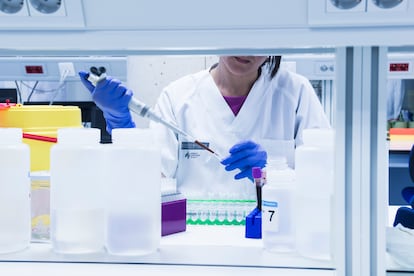The boom of the anti-aging market: How to get people to live to be 120 (and in good health)
This thriving industry — which aims to reverse or delay age-related disease — will be worth around $610 billion globally by 2025


Suppose you’re given the option to live for 120 years. Many of us would probably consider accepting the tempting offer. But remember, during the last 40 years of this extended existence — 14,600 days — you could suffer from pain, mobility problems, dementia, macular degeneration, heart disease and other chronic illnesses. Upon reflection, most of us would probably reject the proposal. Gaining years of life implies getting old — the toll on the body and the mind isn’t minor. At least, for now.
The world is about to experience a revolution that will change absolutely everything. The emerging anti-aging industry — estimated to be worth around $610 billion by 2025 — is seeking to unravel the changes and processes involved in the development of age-associated diseases, injuries and disabilities. This in order to delay them, reduce the damage they cause, or reverse them.
Old age, a physiological process that occurs in all organisms, leaves its marks. These include genomic instability, telomere shortening, mitochondrial dysfunction, cellular senescence, stem cell depletion and chronic inflammation. Aging also triggers the risk of suffering from Alzheimer’s — it affects some 50 million people worldwide — and cancer, with the probability of having the disease past the age of 80 being at nearly 50%. Old age also bolsters the risk of developing Parkinson’s, heart disease, muscle fragility, arthritis, tissue fibrosis, type 2 diabetes, obesity and many other conditions. “These diseases can and should be prevented and, of course, delayed,” says José Viña, a professor at the University of Valencia, Spain. He’s also the director of research at INCLIVA — the Biomedical Research Institute — and CIBERFES, the Biomedical Research Center in Frailty and Healthy Aging.
Biotechnology research on aging and longevity is currently experiencing a golden age, supported by billions of dollars in investments from venture capital, the pharmaceutical industry, non-profit organizations and wealthy families. Much of the funds that this sector receives comes from the pockets of the world’s richest men, such as Jeff Bezos (Amazon), Sam Altman (ChatGPT), Larry Page (Google) or Peter Thiel (PayPal). Cloaked with a bit of secrecy, they finance biotech start-ups that go a step further, researching cell reprogramming to restore health, so that people can live longer, healthier lives.
The big names in Silicon Valley have set their sights on this field of science, which has attracted attention for centuries and may now be poised to completely change the way we age. “These [tech giants] aren’t afraid of big changes — they love innovation. Also, people from the world of blockchain and cryptocurrencies are very interested. In fact, in 2021, we received almost $28 million in digital currency. It was the largest digital currency-based philanthropic campaign in history,” says Maria Entraigues, the director of development at the Foundation for the Research of Engineered Negligible Senescence (SENS), which researches methods that can repair age-related damage to human tissue.
The stakes are so high that, according to Dmitry Kaminskiy and Margaretta Colangelo — authors of Longevity Industry 1.0 — the biotech company that proves capable of achieving tangible anti-aging results will become the next Google. There are currently 50,000 companies in 20 sectors looking into this, with more than 10,000 investors, according to data from the Aging Analytics Agency. Clearly, good health is the new wealth for investors.
In the next decade, research into the biology of aging could deliver unprecedented increases in the quality and length of human life. “The idea is to add healthy years to life. It’s not only about the lifespan, but the healthspan (the years that a person is free of diseases). The extension of the lifespan would be a consequence of having better health for more years. Undoubtedly, we could live more than 100 years in good health,” Entraigues affirms. Today, the average life expectancy worldwide is 72 years.
At least in advanced societies, living in a healthy manner beyond the age of 100 could be common in coming decades. However, Professor José Viña believes that the idea of eternal life must be discarded, so as not to deceive people with unattainable goals. “By eradicating all diseases, many of us could reach the maximum lifespan, of about 120 years. Several research groups — including ours — have managed to extend life by between 20% and 30% in mice, which is the equivalent of 20 years in people. But it hasn’t been possible to double the longevity of a mouse.” Viña is firmly against generating false expectations, much less “promising things — like living 150 years or more — that aren’t within our reach right now.”
Alejo Rodríguez-Fraticelli, at the Biomedical Research Institute in Barcelona, works on blood aging. “[We’re trying] to tackle the causes of aging and see the impact on different diseases, with the aim of reaching 90 years [while feeling] as if you were 50.” He’s aware of the challenges, but also emphasizes that “[anti-aging] therapies will be able to offer a more just and happy society.”
An unaffordable expense
Making human beings live longer in good mental, neurological and physical health would be one of the most important steps humanity has ever taken. Not only because of the suffering experienced by millions of people around the world, but also because of the massive impact it would have on society, the economy and the public policies of any state. Many countries are under the threat of unsustainable spending, due to the high cost of chronic and degenerative disease. In Spain, for example, health spending related to old age will grow by 18% over the coming decade, reaching over $100 billion annually, according to Moody’s.
We must not forget that the planet rests on a demographic time bomb, one of the mega-threats that economist Nouriel Roubini writes about in his best-selling books. The population is aging at an unprecedented rate. It’s estimated that, by 2030, there will be 1.4 billion people over the age of 60 worldwide. In 2050, this figure will top 2.1 billion, according to the World Health Organization.
Many have tried to calculate the value of the gigantic anti-aging industry. There are numerous projections, but they vary enormously, depending on the fields that are taken into account. These range from preventive medicine to the reprogramming of cells. Bank of America (BOFA) estimates that the value of the global industry will amount to around $610 billion by 2025. Currently, the market is at around $110 billion, while the annual growth rate is at 28%, says BOFA analyst Felix Tran. These figures take into account five areas that will be key to anti-aging: genomics, big data and artificial intelligence, food for the future, amortality, as well as “moonshot medicine” (projects that propose radical ideas to big problems with the help of technology). “The genomics market alone is growing at a rate of 14% per year, [set to reach] $41 billion by 2025,” Tran adds.
On the other hand, the projection by the Aging Analytics Agency is more ambitious and broad, even taking into account the financial services markets, such as pension plans and life insurance. It estimates that the longevity economy will reach $33 trillion by 2026.
However, the risks and pitfalls of this industry are as significant as its potential. The most obvious hurdle is to make human trials successful. The second is to demonstrate to regulatory authorities the validity or necessity of drugs in this area. For example, the FDA has been reluctant to approve longevity therapies unless a specific clinical condition is being targeted.
The third obstacle is the time it takes for an experiment to become an actual drug or therapy. “The cycle of biotechnological innovations is very long and it can take up to 12 years for [these drugs or therapies] to reach the market,” warns Ion Arocena, general director of the Spanish Association of Biocompanies. This is on top of the inequalities and ethical questions that longevity therapies could cause.

Aging research has evolved enormously in recent years, thanks to scientific and technological advances. There are various studies that are in different stages of development, some with promising results. This is the case with senolytic drugs — which cause senescent cells that accumulate in aged tissues to die and disappear — and mitochondrial replacement therapies. Different start-ups are working on treatments to restore or replace aging mitochondria, such as Mitrix Bio, Cellvie, Stealth BioTherapeutics and Yuva Biosciences. There are also several drugs — including metformin, a well-known antidiabetic — that have proved effective in animals and during small human trials, but have not yet been confirmed via large randomized trials.
Federico Pallardó Calatayud, a researcher at the Biomedical Research Center in Frailty and Healthy Aging, explains that “various genes and molecular pathways related to aging have been discovered that have offered very good results in animal testing.” The results are promising, although the problem of neurodegeneration is perhaps the great stumbling block. “It’s of little use to us to be in good physical condition if we don’t have preserved cognition at the same time.” As of this month, the FDA approved Leqembi (lecanemab-irmb), a medication for the treatment of adult patients living with Alzheimer’s. The drug will be included under Medicare coverage, which will allow millions of elderly American patients to access it.
If cell reprogramming — which won Shinya Yamanaka the 2012 Nobel Prize for Medicine — proves feasible after extensive testing in mice, it could restore health and resistance to human cells. “2021 and 2022 saw billions in funding and [the founding] of several [biotech] companies,” according to a QuadraScope report. The most notable are Altos Labs, NewLimit, Calico, Life Biosciences, Rejuvenate Bio and Turn Biotechnologies.
Altos Labs is a biotechnology company founded in 2021, with unusually significant financing: $3 billion. By comparison, the largest publicly-funded science body in Spain, the CSIC, has an annual budget of less than $1.2 billion. Different publications have stated that a good part of the money invested in Altos Labs comes from the pockets of billionaire Jeff Bezos, who is looking for eternal life. The company — which has offices in San Francisco, San Diego and Cambridge (United Kingdom) — neither confirms nor denies the support of Bezos. In an email, representatives of the firm limited themselves to noting that “the founders of Altos are Richard Klausner, Hal Barron and Hans Bishop. Juan Carlos Izpisúa Belmonte is the founding scientist. The company has not disclosed investors other than ARCH Venture Partners.”
Altos Labs — which has recruited four Nobel Prize laureates — works on cell rejuvenation programs, with the aim of reversing diseases, injuries and disabilities that can occur throughout life. “Conventional drugs focus on attacking parts of the biology of a disease. We’re exploring whether we can understand the deep biological mechanisms of cell health and resistance and modulate them, enhancing the cells’ ability to resist or suppress disease,” the company explains. Regarding eternal life, they flatly deny that this is their objective. In the words of one of the founders, “if what Altos does ends up prolonging life, it will be a happy accident.”
The company expresses optimism, but doesn’t impose deadlines. In an interview from March of 2022 with EL PAÍS, Izpisúa said: “Within two decades, we’ll be able to prevent aging.” However, he’s aware of the risks. “The growth potential is enormous, but the return on investment is yet to be determined. Anyone in this field needs a high tolerance for risk.”
There are other billionaires who are financing this industry. Sam Altman — who has made his money as the CEO of ChatGPT — has invested in the biotech company Retro Biosciences, according to MIT Technology Review. Back in 2013, Larry Page — the co-founder of Google — announced the creation of the San Francisco-based Calico. The company, which hasn’t responded to this newspaper’s questions, indicates on its website: “We want to discover and develop interventions that allow people to live longer and healthier lives.”
This is just the tip of the iceberg. What lies beneath the surface is an explosion of longevity-focused biotech start-ups that need large amounts of capital and are being financed privately, both by specialized investment funds and by venture capital firms, which – until recently – were focused on technology companies. They’ve now set their sights on the anti-aging sector.
Private capital
The growing investment in this field has been driven by increasing scientific knowledge of the biological process of aging. “Longevity could become the biggest industry of the future, as everyone is interested in living a healthy, happy and maybe longer life,” says Marc P. Bernegger, a founding partner of Maximon — a Swiss company that supports and finances the creation of companies focused on longevity. With four companies from the industry in its portfolio, including Avea and Biolytica, Maximon has just announced that it has raised $33 million in new financing.
In Europe and the United States, there are already investment funds focused exclusively on start-ups that are trying to tackle the devastating effects that the passage of time has on cells and molecules. “Around $5.2 billion of funds were raised by companies at various stages of their development in the global longevity industry,” estimates Damien Ng, executive director of thematic research at the Julius Baer Group. A decade ago, this sector barely had half-a-billion in capital. Ng believes that investment in anti-aging research will continue to rise: “The market should be able to raise more than $15 billion by 2030 in innovative therapeutic areas such as cell programming, cell membrane restoration and regenerative medicine.”
Pharmaceuticals are also beginning to get involved, while non-profit foundations are also playing an important role. The Saudi royal family wants to become one of the largest investors in anti-aging research, having launched the Hevolution Foundation, which plans to invest $1 billion a year in financing anti-aging research. “Our goal is to better understand the biology and the aging process to facilitate the development of therapies and preventive drugs that can be useful against many of the ills that afflict us as we age,” says CEO Mehmood Khan via email. He was once an endocrinologist at the Mayo Clinic and chief scientific officer at PepsiCo. Dr. Mehmood adds: “Allowing and extending life expectancy in good health isn’t just an opportunity — it’s an imperative.”

Spain gets hooked
In Spain, the longevity sector hasn’t stopped growing, although when compared to other European countries and the United States, it’s still quite new. “The Spanish biotechnology industry has more than 400 [research projects underway] for the treatment of multiple diseases associated with aging, such as Alzheimer’s, Parkinson’s or musculoskeletal disorders,” explains the Spanish Association of Biocompanies. Firms such as Life Length stand out — the only laboratory in Spain with its own patented technology that measures telomeres, to determine biological age and the state of cells. “Our main objective is prevention, which will result in greater longevity and a better quality of life,” the company notes.
Spanish biotechnology, which includes the aging sector, has nearly 900 companies focused mainly on human health and food, which, in 2021 had a turnover of around $14 billion, representing 1% of Spanish GDP. Biotech, which generates 118,000 jobs, or 0.65% of overall employment, took in more than $150 million in investments in 2022, 21% less than the previous year. Despite this, the figure is still “well above the data prior to the COVID,” says Arocena.
Ysios Capital — a Spanish venture capital firm that provides financing to life sciences companies — highlights what happened after the pandemic: “We’ve noticed greater interest from investors, who previously didn’t consider including a biotechnology venture capital fund among their investments, due to the associated risk.” The firm currently has more than 400 million euros ($450 million) in three funds. At Asabys Partners — which invests in life sciences, medical devices and digital health, managing 117 million euros ($131 million) — they receive about 25 investment proposals each week. “We’ve invested in 15 companies so far… much less than 1% of proposals that we look at,” notes Clara Campàs, who co-founded Asabys with Josep Lluís Sanfeliu in 2019.
Delaying, slowing down or even ending the decline associated with old age would mean a social and economic revolution. An analysis by the London Business School and the University of Oxford showed that a slowdown in aging that increases life expectancy by just one year is worth $38 billion annually, or $367 billion if lifespans grow by 10 years.
Maria Entraigues, the director of development at the Foundation for the Research of Engineered Negligible Senescence (SENS), talks about the enormous economic prosperity associated with “unleashing the potential of humans with more experience who, due to the deterioration of old age, are discarded in today’s society.” This would mean saving huge amounts of money from the public coffers. Damien Ng, from Julius Baer, shares this opinion. “[Anti-aging] has the potential to contribute to GDP growth through changing patterns of consumption, employment, savings and human capital.” This would be due to the fact that a large part of the population would have more years of productivity. “It could mean not just avoiding economic stagnation, but boosting growth,” Khan adds.
The problem lies in whether governments will be able to look at old age with different eyes. “The government budget in the U.S. [devoted] to studying the biology of aging is tiny compared to what we have to treat symptoms and extend the period of old age,” Entraigues laments. Rodríguez-Fraticelli agrees: “We have to change the public perspectives on investment in aging.” In Spain, which has adopted this approach, the government allocated 325 million euros ($364 million) in 2022 towards biomedical and health research and development.
Fasten your seatbelts, because this journey has only just begun. Regarding the hypothesis of eternal life, perhaps we should pay attention to Nobel Prize winner José Saramago: “The worst punishment would be to live forever.”
A long-term play
You don't have to be Jeff Bezos to invest in biotech, even though the industry is often considered risky, due to the uncertainty surrounding clinical trials and regulatory approvals (medicines and therapies go through three phases of clinical trials before they are authorized and made available to patients). It’s a very complex process, since the cycle of biotechnological innovations ranges between 10 and 15 years, or even longer. “Translating intriguing animal studies to humans is difficult… and most clinical trials of new drugs don't work,” says Mehmood Khan, the CEO of the Saudi-financed Hevolution Foundation.
“The profitability of these companies depends on clinical data,” explains Álvaro de la Rosa. He works at Abante, an advisory firm that has a fund dedicated to investing in health, life sciences, biotechnology and medical software. For this reason, “the best investment option is to diversify between the small companies that don’t have approved drugs and that are more volatile, and the large ones, [which already have] products on the market,” says De la Rosa, who doesn’t believe that we’re in a biotech bubble. “In 2021 and 2022, [the biotech sector] has lagged quite a bit. Therefore, valuations are quite attractive.” On the Nasdaq, the return on biotech investments over the last five years has averaged 4.2%.
Risk — which, in addition to clinical or scientific issues, encompasses commercial and financial factors — is inherent to investing in biotechnology. “The key lies in identifying [risk factors] at an early stage, working to reduce them and knowing how to make the right decisions,” explain the representatives of Ysios Capital. As Julius Baer's Damien Ng puts it, longevity investors and company founders must be prepared to play the “long game.”
Sign up for our weekly newsletter to get more English-language news coverage from EL PAÍS USA Edition








































